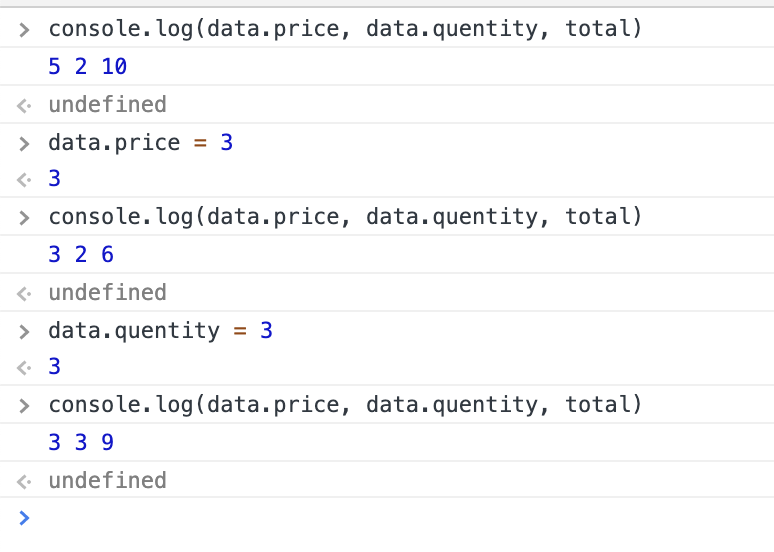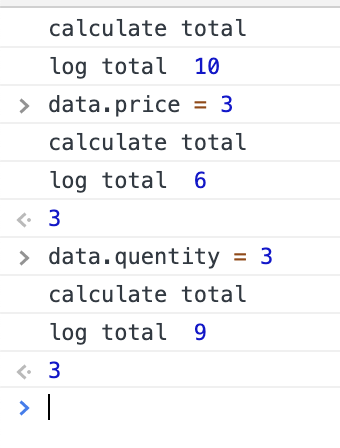vue 响应式原理
前言
当你更新 vue 实例的某个属性,使用该属性的方法随之重新执行,你或许知道这是 vue 通过 defineProperty 实现的响应式系统,但具体是如何实现的,define 了哪些 property?
本文用 vue 源码中相同的模式、原理,以不到一百行的代码,实现了一个简单的响应式系统,希望本文对你理解 vue 有所帮助。
角色与关键点
从小片段开始
let price = 5
let quentity = 2
let total = price * quentity
在上述的代码片段中,有两种角色:变量、计算过程
price、quentity、total 是变量,total = price * quentity 是计算过程
在当前情况下,更新 price 或 quentity,并不会导致 total更新 —— 除非,重复执行计算过程。
即:在检测到 price 或 quentity 变化时,重新执行 total = price * quentity
此处有几个关键点:
- 检测
price与quentity的变化 - 由于
price与quentity的变化后需要重新执行计算过程,因此需要将计算过程total = price * quentity保存到某个地方,以便后续重新执行 - 将变量与计算过程关联,即程序需要明确在
price变化后执行对应的total = price * quentity计算过程
原理与思路
调整下上面的代码,将计算过程保存到函数 cb 中
let price = 5
let quentity = 2
let total = 0
function cb() {
total = price * quentity
}
cb()
现在,在 price 或 quentity 更新后,手动执行 cb,即可得到更新后的 total。我们需要这个过程自动执行,就需要解决上述中的关键点。此外,我们还可以应用观察者模式让代码结构更加清晰。
先捋下角色以便使用观察者模式。price 或 total 这类变量变化后需要通知 cb 这一计算过程执行,因此,price 与 total 是观察对象,cb 是观察者。又有,cb 的执行依赖于 price 和 total,因此,可以说 price 与 total 是 cb 的依赖。
场外:观察者模式中,
cb是price和total的观察者或者说订阅者(subscriber);在cb执行过程中,price和total又是cb的依赖(dependency),这些角色体现在了 vue 源码的变量命名中,因此需要搞清角色间的关系
由上所述,对应每个变量,建立一个 Dep 类;对应每个计算过程,建立 Watcher 类。Dep 类是观察对象,实现观察对象相关接口,Watcher 是观察者,实现观察者相关接口。
再来看前面提到的关键点,对于检测 price 与 quentity 的变化,我们可以将 price 与 quentity 作为某个对象(比如 data)的属性,通过 defineProperty 属性描述符的 set 定义 price 与 quentity 属性的 setter 方法来实现。setter 方法会在每次给属性赋值时被调用,当检测到赋值发生了变化,调用属性对应的 Dep 实例的 notify 方法,通知相关 Watcher 进行 update(此处的 notify 与 update 是观察者模式相关接口)
对于将计算过程 cb 保存到某个地方,目前很明确,就是保存在 Watcher 中。
场外:
Dep作为观察对象,内部需要维护一个订阅者(观察者)列表 ——subs,subs中的每一项都是Watcher,这样,当变化发生,调用Dep的notify方法,在notify中遍历subs,调用每个Watcher的update方法。而update具体要做的事就是重新执行一遍cb
对于如何将变量与计算过程关联,即知晓某一计算过程依赖哪些变量。我们再来看下 cb 这一计算过程:
total = price * quentity
在 cb 这一计算过程中,它 读取了 price 和 quentity 的值,然后将其相乘并 赋值到 total 上。上面我们说 price 和 quentity 是 cb 的依赖,从这里我们又发现,cb 在执行过程中会 读取 它依赖的变量的值。注意这里 total 的重新赋值是 cb 产生的影响,cb 的计算只依赖于 price 和 quentity
回想我们要的响应式系统,在首次执行某个计算过程后,若后续该计算过程中的依赖变量发生变化,重复执行该计算过程。结合上述,如果我们在首次执行 cb 时,能 代理 cb 对 price 和 quentity 的 读取,即可建立变量与计算过程的关联。
而 代理 cb 对 price 和 quentity 的 读取,可以通过 defineProperty 属性描述符的 get 定义 price 与 quentity 属性的 getter 方法来实现,即在 getter 中建立变量与计算过程的关联。
从上面的观察者模式来说,cb 存储在 Watcher 中,price 和 quentity 各自对应一个 Dep,是观察对象,这里的建立联系就是将 Watcher 添加到 Dep 的订阅者列表中。
场外:这里还可以再绕一层,
Dep对应的变量是Watcher对应的计算过程的依赖,建立联系的过程就是给Watcher添加依赖。至于如何给Watcher添加依赖,依据观察者模式,仍是将Watcher添加到Dep的订阅者(观察者)列表(subs)中。
梳理总结
到这里,实际上已经完成了 vue 的响应式原理。我们梳理下过程:
- 初始化变量,即设置变量的
getter与setter- 在
getter中建立变量与当前执行的计算过程的关联 - 在
setter中通知订阅者更新
- 在
- 首次执行计算过程,触发变量的
getter进行依赖搜集 - 等待变量重新赋值,触发计算过程再次执行
代码实现
将变量包裹到 data 对象中并移除手动首次调用 cb
const data = {
price: 5,
quentity: 2
}
let total = 0
function cb() {
total = data.price * data.quentity
}
定义 Dep
class Dep {
static target
constructor() {
this.subs = []
}
addSub(watcher) {
this.subs.push(watcher)
}
notify() {
this.subs.forEach(watcher => watcher.update())
}
}
Dep.target = null
定义 Watcher
class Watcher {
constructor(cb) {
this.cb = cb
this.get()
}
get() {
Dep.target = this
this.cb()
Dep.target = null
}
update() {
this.cb()
}
}
响应式方法
function walk(data) {
Object.keys(data).forEach(function defineReactive(key) {
const dep = new Dep()
let value = data[key]
Object.defineProperty(data, key, {
get: function() {
if (Dep.target) dep.addSub(Dep.target)
return value
},
set: function(newValue) {
if (value === newValue) return
value = newValue
dep.notify()
}
})
})
}
使用
walk(data)
new Watcher(cb)

再总结一波
vue 组件实际的页面是通过 render 函数渲染出来的,而首次执行 render 函数的过程,就是上面 Watcher 收集变量依赖的过程,之后,当变量出现变化,就会触发依赖该变量的方法重新执行,最终导致页面重新渲染。

而在 vue 生命周期的 beforeCreate 和 Created 之间的初始化操作,就是对变量进行响应式处理,也就是前面的 walk 操作。

彩蛋
把 walk 与 new Watcher(cb) 的动作放到一个新的类中,如 MiniVue:
class MiniVue {
constructor({ data, methods }) {
this.walk(data)
this.firstRun(methods)
}
firstRun(methods) {
Object.keys(methods).forEach(key => new Watcher(methods[key]))
}
walk(data) {
Object.keys(data).forEach(function defineReactive(key) {
const dep = new Dep()
let value = data[key]
Object.defineProperty(data, key, {
get: function() {
if (Dep.target) dep.addSub(Dep.target)
return value
},
set: function(newValue) {
if (value === newValue) return
value = newValue
dep.notify()
}
})
})
}
}
然后就可以:
const data = {
price: 5,
quentity: 2,
total: 0
}
new MiniVue({
data: data,
methods: {
calculateTotal() {
console.log('calculate total')
data.total = data.price * data.quentity
},
logTotal() {
console.log('log total ', data.total)
}
}
})

注意:这里对 methods 的操作只是仿了个 vue 初始化的样子,实际环境中的 vue 并不是 这样处理 methods 的。
参见:
场外:当我意识到 vue 响应式的实现使用了观察者模式,且变量为观察对象,计算过程为观察者后,我便很快理解了这部分代码。
